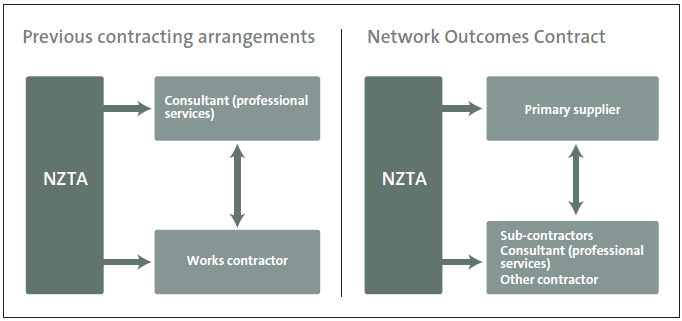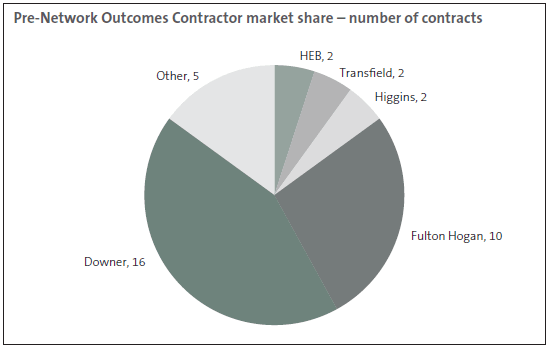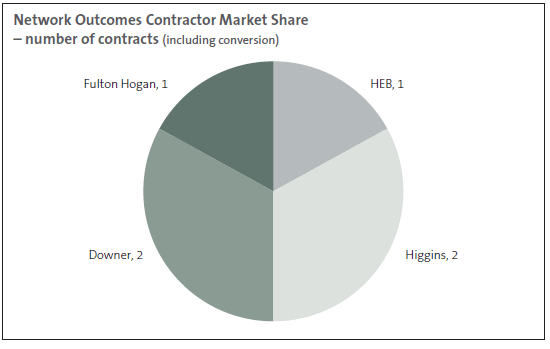Part 4: Designing and selecting service delivery models
4.1
When we carried out our second audit, NZTA used a range of service delivery models to deliver maintenance and renewals work on the network. The models used were Traditional, Hybrid, Performance Specified Maintenance, and Alliance.
4.2
These models took different forms. However, they typically involved a contract between NZTA and a professional consultant, and a further contract between NZTA and the physical works contractor. The professional consultant was responsible for strategic asset management and for managing the contract with the physical works contractor.
4.3
Our second report concluded that NZTA had a clear understanding of its supplier market and had been responsive to recent market conditions. Also, NZTA sought to achieve cost-effectiveness by using a range of different models for employing consultants and contractors to do maintenance and renewals work.
4.4
However, NZTA needed to prepare, and review on an ongoing basis, specific strategies to encourage more suppliers into some areas of maintenance and renewals work, such as the professional services area.
The new Network Outcomes Contracts
4.5
NZTA is now introducing new Network Outcomes Contracts for all its maintenance and renewals work. These will replace the previous models.
Main features of the new Network Outcomes Contracts
4.6
Under a Network Outcomes Contract, NZTA usually engages a primary supplier to provide all network management and maintenance activities. The primary supplier then engages consultants and sub-contractors to deliver the required services. For at least one contract, the primary supplier is a joint-venture company. NZTA continues to engage separate suppliers to deliver some specialist asset management activities.
4.7
Figure 3 compares the previous contracting arrangements and Network Outcomes Contract contracting arrangements.
Figure 3
Previous and new contracting arrangements for maintenance and renewals work

Source: Office of the Auditor-General.
4.8
Other features of the Network Outcomes Contracts include:
- increased contract tenure (up to nine years, subject to primary supplier performance);
- increased bundling of contracts (that is, including different types of activities in one contract);
- fewer contracts – there will be 23 geographically focused contracts;8
- using key performance indicators and performance incentives to ensure that desired outcomes are achieved;
- two fee components – a lump sum (fixed fee) component and a “measure and value” component based on a schedule of unit rates;
- standardised terms for all contracts; and
- enhanced data-reporting requirements.
Reasons for introducing Network Outcomes Contracts
4.9
NZTA set out the reasons for introducing Network Outcomes Contracts in a July 2012 consultation document.9 The main reasons were to increase effectiveness and efficiency, and to reduce costs. In particular:
- Longer-term contracts would save NZTA money through economies of scale and scope. For suppliers, longer-term contracts would reduce the administrative costs of re-tendering after shorter terms and give them increased certainty after they have been awarded the contract.
- Fewer contracts, based on the 23 regions, would deliver increased efficiency. It would also significantly reduce administrative and tendering costs, enable optimal use of resources, and support enhanced capability-building throughout the industry by more strategically allocating people and expertise.
- All-inclusive contracts would encourage greater accountability by suppliers for the overall performance of the network and therefore deliver efficiencies. As well as financial savings from improving the co-ordination of works on any specific road, it could improve the road users’ experience by ensuring that there is co-ordinated programming of works.
4.10
Other potential benefits from Network Outcomes Contracts are that they:
- should help to benchmark contractor performance by using a standard contract;
- shift the emphasis from what services a contractor will offer to what outcomes they will achieve; and
- allow NZTA to have greater influence over the timing and type of some works.
Network Outcomes Contracts and market competition
4.11
Under section 25(2) of the Land Transport Management Act 2003, in approving any procurement procedure, NZTA must have regard to “encouraging competitive and efficient markets for the supply of outputs required for approved activities”.
4.12
Our second report recommended that NZTA have specific strategies to encourage more suppliers into the professional services market for maintenance and renewal work. We consider that NZTA should also encourage competitive and efficient markets for physical works services.
4.13
NZTA also wants to see more competition in the market. For example, it would like to have four to six primary suppliers competing in all parts of the country. This would be a significant change to its current risk of having one supplier in the consultancy/designer market and two suppliers in the maintenance physical works contractor market.
4.14
To increase market competition, NZTA has introduced several mechanisms to reduce barriers to entry into the contracting market. These include:
- allowing consultants and contractors to be involved in more than one bid for each Network Outcomes Contract, but be the primary supplier in only one;
- requiring each bid to provide for sub-suppliers up to a minimum level depending on the road maintenance market for each contract, with a default minimum of 20%; and
- requiring suppliers to state how they will support a competitive market as part of the bidding process.
4.15
NZTA sought advice on its approach from consultants in November and December 2013. The consultants’ reports supported the steps NZTA had taken to lessen the risk of its actions reducing market competitiveness.
4.16
However, Network Outcomes Contracts have not been without adverse comment.
4.17
For example, in November 2013, the New Zealand Institute of Economic Research (NZIER) reviewed cost escalations in the road building, maintenance, and operations sector for the Ministry of Transport. In doing so, it looked at NZTA’s introduction of Network Outcomes Contracts. The NZIER concluded that:
A key additional factor looking forward is the effect that the procurement approach will have on market structure and conduct. There is a risk that reducing the number of contracts and holding those contracts for periods of up to 9 years will create barriers to entry leading to further market concentration. This would create the risk of significant reductions in competition over the long term and consequential increases in prices.10
4.18
The NZIER also expressed doubts about the underlying rationale for moving to Network Outcomes Contracts.11
4.19
We are aware of some potential risks with Network Outcomes Contracts:
- It is possible that the market will comprise a small number of big contractors and a large number of small sub-contractors, with no sub-contractors in the middle. This has been referred to as a “hollowing-out” of the market. It would reduce the likelihood of a small player having a legitimate chance to grow to be a mid-tier firm and then win a major contract.
- Although long-term contracts might encourage suppliers to invest in their capacity, it also could result in fewer contractors having the capacity to enter bids.
4.20
The new contracting model has changed the way in which the professional services market operates. For example, some former professional services consultants now work as part of NZTA’s staff, and others now work for a primary supplier. We did not look at how these changes might have affected the overall capacity in the professional services market, as this was outside the scope of our follow-up work.
Early indications of application of the new contracting model
4.21
NZTA began implementing the new contracting model in 2013. It intends to phase in the 23 geographical contracts over three years. The Appendix sets out the 23 geographical areas.
4.22
NZTA is on track with its implementation programme. To date, NZTA has entered into four new Network Outcomes Contracts (South Canterbury, Taranaki, Bay of Plenty East, and Wellington) and two contract conversions (Marlborough Roads and Wanganui East.) A further two network areas are at various stages of contract procurement (Bay of Plenty West and Central Waikato).
4.23
Figure 4 shows the contracts tendered and converted to date.
Figure 4
Network Outcomes Contracts that have been tendered and converted
| Network Area | Number of tenderers | Price | Term |
|---|---|---|---|
| South Canterbury | 4 | $70 million | 7 years |
| Taranaki | 3 | $56 million | 7 years |
| Bay of Plenty East | 3 | $79 million | 7 years |
| Wellington | 3 | $106 million | 7 years |
| Marlborough Roads* | n/a | $66 million | 5 years |
| Wanganui East* | n/a | $19 million | 2 years |
* Conversions.
Source: Redrawn from a table supplied by NZTA.
4.24
Figure 5 compares market share for the pre-Network Outcomes Contracts environment and for Network Outcomes Contracts.
Figure 5
Comparison of market share for the pre-Network Outcomes Contracts environment and for Network Outcomes Contracts


Source: Redrawn from a figure supplied by NZTA.
4.25
Although only a small number of Network Outcomes Contracts have been tendered, NZTA considers that it is seeing encouraging signs of market competitiveness. Three to four tenderers have been involved in each tendered contract, and contracts have been awarded to a good mix of primary suppliers. However, the number of tenderers does not necessarily mean a healthy and competitive market, particularly in the short term. A better measure is the number of different tenderers awarded contracts.
4.26
NZTA told us that initial results show tangible savings to NZTA from reduced contracting costs and through revised specifications. The revised specifications include changes in customer levels of service and more targeted activities, particularly with renewals investment.
4.27
NZTA has analysed the pricing for the tendered contracts. It compared Network Outcomes Contracts pricing to pre-Network Outcomes Contracts pricing. NZTA told us that this analysis shows predicted savings over historical costs. As noted above, these savings are derived from reduced costs and reduced activities.
4.28
NZTA needs to establish robust baseline information, so it can accurately compare the effects of the new contracting arrangements with historical costs. For example, it needs to be clear about which costs savings arise from reduced volumes of activity, rather than efficiency gains. Baseline costs should also reflect the changes to organisational arrangements, such as NZTA bringing some professional services capacity in-house.
4.29
In our view, it is too early to come to any definitive conclusions. It is critical that NZTA continues to monitor market behaviour and be prepared to adjust its procurement practices if necessary. We also expect NZTA management to report regularly to the NZTA Board on the state of the market, given the importance of the issue.
Source: NZTA.
8: There were previously 37 network contract areas. The Auckland Motorway Alliance will still be an alliance arrangement.
9: New Zealand Transport Agency, State Highway Maintenance and Operations Review, consultation document, July 2012.
10: New Zealand Institute of Economic Research, Construction industry study, Implications for cost escalation in road building, maintenance and operation, report prepared for the Ministry of Transport, November 2013, page i.
11: New Zealand Institute of Economic Research, Construction industry study, Implications for cost escalation in road building, maintenance and operation, report prepared for the Ministry of Transport, November 2013, pages 61-62.
